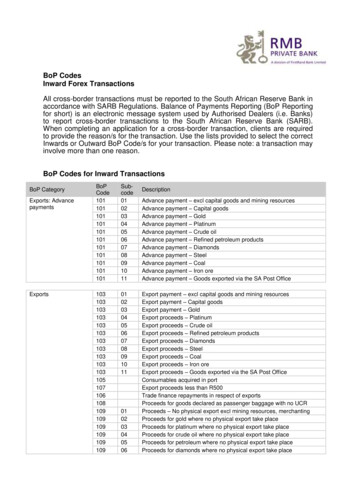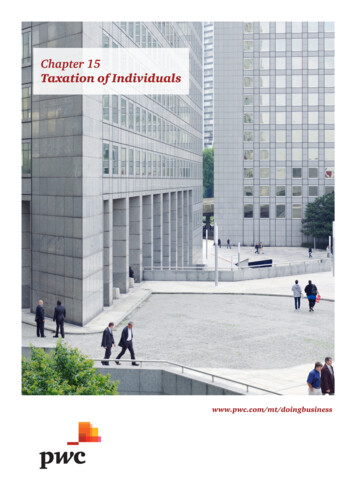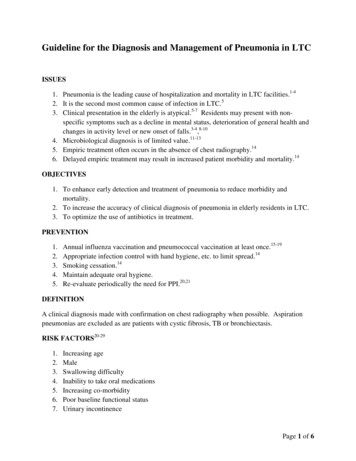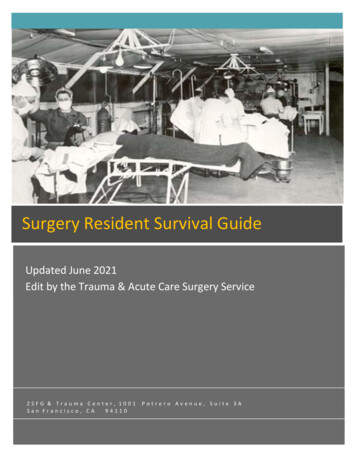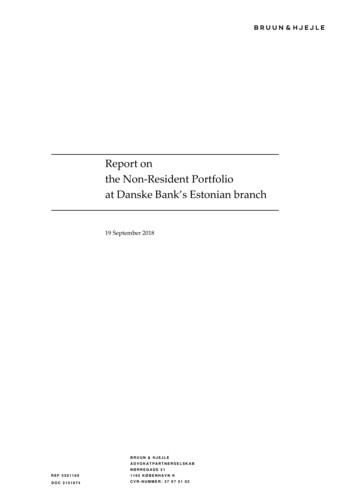
Transcription
Report onthe Non-Resident Portfolioat Danske Bank’s Estonian branch19 September 2018BRUUN & HJEJLEADVOKAT PART NERSEL SKA BNØRREGADE 21REF 53011691165 KØBENHAVN KDOC 3151674CVR-NUMMER: 37 97 51 92
List of 39.49.510.10.110.210.310.410.511.Executive summary . 3Background . 3Scope of the report . 4Looking back . 4Key takeaways . 5Structure of the report .10AML regulation and practice .11AML regulation .11AML practice and information available to a financial institution .12Portfolio Investigation .15Purpose and scope .15Overall conduct of the Portfolio Investigation .15Methodology regarding customers .16Methodology regarding employees and agents (possible internal collusion) .17Accountability Investigation .19Purpose and scope .19Overall conduct of the Accountability Investigation .19Methodology.19Non-Resident Portfolio.22Overview .22Number of customers .22Deposits .25Profits .26Customers subject to investigation .26AML procedures in the Estonian branch .27Activity of customers in the Non-Resident Portfolio .28Payments .28Suspicious customers in the Non-Resident Portfolio .29Possible criminal activity of customers .34Employees and agents engaged by the Estonian branch .35Overview of events .37Organisational overview .37Acquisition .39Operation .41Termination.50Investigation .73Individual accountability .77Introduction .77Overview .77Board of Directors .79Chairman of the Board of Directors.82Chief Executive Officer .83Definitions and abbreviations .87DOC 31516742
1.Executive summary1.1BackgroundDanske Bank A/S (“Danske Bank”) is the largest financial institution in Denmark withfocus on the Nordic region and presence in sixteen countries. Danske Bank is listed onthe Nasdaq OMX Copenhagen stock exchange. In Denmark, Danske Bank offers, inaddition to banking services, life insurance and pension, mortgage credit, wealth management, real estate and leasing services. Danske Bank has a total of 2.7 million personal customers, 211,000 small and medium-sized business customers, and 2,000 corporate and institutional customers. Danske Bank is licensed by the Financial Supervisory Authority (“FSA”) in Denmark, which considers Danske Bank to be one of sixsystemically important financial institutions in Denmark. Systemically important financial institutions are deemed essential to the financial system.Until early 2016, Danske Bank had in its Estonian branch a portfolio of some thousandscustomers residing outside Estonia (the “Non-Resident Portfolio”). The Estonianbranch and the Non-Resident Portfolio had become part of Danske Bank when in 2007Danske Bank acquired Finnish-based Sampo Bank. The Non-Resident Portfolio included customers from the Russian Federation and the larger Commonwealth of Independent States (“CIS”), including countries such as Azerbaijan and Ukraine.The Estonian branch had its own IT platform. This meant that the branch was not covered by the same customer systems and transaction and risk monitoring as DanskeBank Group headquartered in Copenhagen (also referred to as “Group”), and it alsomeant that Group did not have the same insight into the branch as other parts of Group.Many documents at the Estonian branch, including information about customers, werewritten in Estonian or Russian.For a long time, it was believed within Group that the high risk represented by nonresident customers in the Estonian branch was mitigated by appropriate anti-moneylaundering (“AML”) procedures. In early 2014, following a report from a whistleblower and audit letters from Group Internal Audit, it became clear that AML procedures at the Estonian branch had been manifestly insufficient and inadequate. Thiscaused a number of initiatives on the part of Group. AML procedures also became subject to harsh criticism from the FSA in Estonia, and Danske Bank was met with regulatory sanctions from both the Estonian FSA in July 2015 and the Danish FSA in March2016. The Non-Resident Portfolio was terminated in 2015 with the last accounts beingclosed in early 2016.Since March 2017, the terminated Non-Resident Portfolio at Danske Bank’s Estonianbranch has attracted significant public interest.In press release of 21 September 2017, Danske Bank acknowledged that it was “majordeficiencies in controls and governance that made it possible to use Danske Bank’sbranch in Estonia for criminal activities such as money laundering”. The press releasemade reference to the findings of a “root-cause analysis” prepared for the bank by USbased consultancy Promontory Financial Group, LLC (“Promontory”). According toDOC 31516743
the same press release, Danske Bank had expanded its ongoing investigation into thesituation at its Estonian branch, which was expected to be completed in the course ofnine to twelve months. This expanded investigation, here referred to as the PortfolioInvestigation, examines the customers in the terminated Non-Resident Portfolio andtheir historical activities, that is payments and other transactions and trading activities.It also investigates possible cooperation between customers and employees with theEstonian branch (internal collusion). Part of the purpose of the Portfolio Investigationhas been to understand, to the extent possible, the activity and to report to the FinancialIntelligence Unit (“FIU”) in Estonia customers found to be “suspicious” as requiredunder Estonian law. By now, the investigation finds to have a good general understanding of the portfolio.In addition to the Portfolio Investigation, there has been a separate investigation intoaccountability. Part of its purpose has been to understand how Danske Bank ended upin this situation. In addition to analysing the bank’s own exposure and legal responsibility as an institution, the investigation has assessed whether individuals in leadingpositions at Group level and also in the Estonian branch failed to comply with legalobligations forming part of their employment or position. This investigation, which ishere referred to as the Accountability Investigation, has been completed.1.2Scope of the reportThis report summarises characteristics of the terminated Non-Resident Portfolio atDanske Bank’s Estonian branch as well as other facts relating to it, including mainevents both at branch and Group level.For legal reasons, it is not possible in this report to share all information relating to theNon-Resident Portfolio. Specific information about customers and employees cannotbe shared. This also includes assessments of individuals. Equally, suspicious activityreports (“SARs”) filed with the Estonian FIU or elsewhere are subject to secrecy. Moreover, information over which Danske Bank exercises legal privilege cannot enter thepublic domain.Financial regulation has established separate channels for reporting and exchange ofinformation between financial institutions and regulators, and Danske Bank continuesto share information on a wider scale with the Danish FSA and the Estonian FSA aswell as other relevant authorities.1.3Looking backThis report looks back into the Non-Resident Portfolio at Danske Bank’s Estonianbranch. The portfolio was terminated in late 2015 with the last accounts being closedin early 2016. As part of the look-back, the report describes AML procedures and ITsolutions then in place at the Estonian branch. The report does not include a descriptionof present-day AML procedures at the Estonian branch, leaving aside AML proceduresin Danske Bank Group at large. It follows from a number of press releases as well asinternal reporting and communication with regulators that Danske Bank has been in-DOC 31516744
vesting in improved AML procedures throughout the Group and also covering the Estonian branch, as also noted by the Danish FSA in its decision of 3 May 2018 on thismatter. On 26 April 2018, Danske Bank publicly announced that the bank would scaledown its Baltic banking activities focusing “exclusively on supporting subsidiaries ofNordic customers and global corporates with a significant Nordic footprint”.1.4Key takeawaysThe description in this report of the Non-Resident Portfolio at Danske Bank’s Estonianbranch and developments from the acquisition in late 2006 until last year includes thefollowing key takeaways:The Estonian branch and non-resident customers1. How the Estonian branch became part of Danske BankIn November 2006, Danske Bank announced its acquisition of Finnish-based SampoBank. The acquisition was completed in February 2007. It included Sampo Bank’ssubsidiary in Estonia named AS Sampo Pank. The majority share interest in this Estonian bank had been acquired by Sampo Bank back in 2000. The seller had been theEstonian Central Bank. In 2002, Sampo Bank had acquired the rest of the shares fromminority shareholders. A year after the acquisition, in 2008, Sampo Pank in Estoniawas turned into a branch of Danske Bank.2. Market share of non-resident depositsThere had been strong economic ties between the Baltic countries and Russia. Sincethe 1990s Sampo Pank in Estonia had had a portfolio of non-resident customers. Bythe end of 2013, the Non-Resident Portfolio within Danske Bank’s Estonian branchheld 44 per cent of the total deposits from non-resident customers in Estonian banks(up from 27 per cent in 2007) and nine per cent of the total deposits from non-resident customers in Baltic banks (up from five per cent in 2007).3. The Non-Resident Portfolio at the Estonian branchThe Non-Resident Portfolio was managed by a separate group of employees, from2013 named the International Banking department and from March 2015 the International Banking division. This Non-Resident Portfolio consisted at any time of between 3,000 and 4,000 customers. At the end of 2015, the International Banking division was closed and the Non-Resident Portfolio terminated, with a few accountsclosed only in early 2016. From 2007 through 2015, there were approximately 10,000customers in total in the Non-Resident Portfolio. These are all subject to the PortfolioInvestigation.DOC 31516745
4. Other non-resident customers at the Estonian branchThe Estonian branch had non-resident customers also outside the Non-ResidentPortfolio. These were non-resident customers not managed by the separate group ofemployees that became the International Banking department and division. In orderto secure completeness, the Portfolio Investigation includes all customers with theEstonian branch with one or more cross-border characteristics, such as address, contact data or ownership outside Estonia. This has increased the total number of customers subject to investigation to approximately 15,000.Activity in the Non-Resident Portfolio5. High activity in the Non-Resident PortfolioFrom 2007 through 2015, there was high activity in the Non-Resident Portfolio. Services offered by the Estonian branch to the customers in the Non-Resident Portfolioconsisted of payments and other transactions in various currencies and also foreignexchange lines as well as bond and securities trading. There were also deposits fromcustomers. As regards the Non-Resident Portfolio, the branch took no credit risks ofany significance. For the same reason, little capital was allocated to the Non-ResidentPortfolio.6. PaymentsThere were incoming payments received by customers in the Non-Resident Portfolio, as well as outgoing payments from these customers to recipients outside theNon-Resident Portfolio. In addition, there were book transfers between the customers, that is internal payments between customers in the Non-Resident Portfolio. Intotal for the approximately 10,000 customers, there were approximately 7.5 millionpayments not including book transfers between the customers (for the 15,000 customers there were approximately 9.5 million such payments).7. Flow of money through the Non-Resident PortfolioFunds transferred from external parties to customers in the Non-Resident Portfolioand subsequently transferred from such customers to external recipients are referredto as “the flow”. Over the nine years from 2007 through 2015, the flow convertedinto EUR for both the approximately 10,000 customers in the Non-Resident Portfolioand the 15,000 customers subject to investigation was approximately EUR 200 billion. Most used currencies were USD and EUR (for purposes of analysis, all payments have been converted into EUR using historical exchange rates).Failed AML procedures at the Estonian branch8. Historical misconception of AML proceduresThe Estonian branch had its own IT platform. This meant that the branch was notcovered by the same customer systems and transaction and risk monitoring asGroup, and it also meant that Group did not have the same insight into the branchas other parts of Group. Many documents at the Estonian branch, including information about customers, were written in Estonian or Russian. For a long time, it wasDOC 31516746
believed within Group that the high risk represented by non-resident customers inthe Estonian branch was mitigated by appropriate AML procedures.9. Failed AML procedures realised by Group in 2014In early 2014, following a whistleblower and new reporting from Group InternalAudit, Danske Bank Group realised that there had been a historical misconception.It was now realised at Group level that AML procedures at the Estonian branch involving the Non-Resident Portfolio had been manifestly insufficient and inadequate.It was also realised that all control functions (or lines of defence) had failed, bothwithin the branch and at Group level. This included business functions as well asGroup Compliance & AML and Group Internal Audit. As demonstrated by GroupInternal Audit in the first quarter of 2014 and by an external consultancy report fromApril 2014, (i) there had been insufficient knowledge of customers, their beneficialowners and controlling interests, and of sources of funds; (ii) screening of customersand payments had mainly been done manually and had been insufficient; and (iii)there had been lack of response to suspicious customers and transactions.Suspicious customers and activity10. Suspicious customersThe Portfolio Investigation has adopted a risk-based approach. A large number ofrisk indicators have been defined, and customers have been run against them andgrouped. In examining customers, a customer-by-customer approach has beenadopted starting with customers hitting the most risk indicators. So far, approximately 6,200 customers have been examined, and the vast majority of these customers have been deemed suspicious. Almost all of the approximately 6,200 customersexamined so far were among the approximately 10,000 customers in the Non-Resident Portfolio.11. Filing of suspicious activity reportsCustomers found to have suspicious characteristics or to have been involved in somesuspicious transactions are being reported to the Estonian FIU in an agreed formatand in accordance with Estonian law. The reporting have the form of suspicious activity reports (“SARs”). It is in addition to the SARs filed historically by the Estonianbranch on 653 customers in the Non-Resident Portfolio (the Estonian branch filedSARs on 760 customers when including the additional 5,000 customers also subjectto investigation).12. Suspicious flowThe fact that customers have suspicious characteristics or have been involved insome payments deemed suspicious does not provide a basis for concluding withreasonable certainty what part of the flow was suspicious. For some customers, allpayments are likely to be suspicious. For other customers, the fact that they havebeen involved in some suspicious payments does not necessarily imply that all theirpayments were suspicious. However, a transaction-by-transaction approach has notbeen adopted, and there is no accurate estimate. It is expected that a large part of thepayments were suspicious.DOC 31516747
13. Criminal activityThe fact that a customer or a transaction is deemed suspicious does not in itself implicate criminal activity on the part of the customer or other party. When filing SARs,the FIU as recipient has the opportunity to collect further information from othersources and to initiate investigation. Money laundering requires proof that fundstransferred are proceeds of a crime. Ascertaining whether this is the case typicallyrequires more information than is possessed by a financial institution.14. Internal collusionFormer and current employees and former agents (persons receiving commissionfor facilitating customers) of the Estonian branch have been examined for suspiciousactivity, ultimately with a view to determining whether they may have been colluding with customers in the Non-Resident Portfolio. 42 employees and agents havebeen deemed to have been involved in some suspicious activity. This is being reported to the Estonian FIU, again in an agreed format and in accordance with Estonian law. Further, eight former employees have been reported to the Estonian policeby Danske Bank. Despite the SARs and police reports filed, it cannot be concludedwith reasonable certainty to what extent criminal activity in the form of collusionhas actually taken place.Events and red flags15. Red flag at the time of acquisitionIn 2007, shortly after completing the acquisition of Sampo Bank, Danske Bank had areal opportunity to conclude that the Non-Resident Portfolio involved suspiciousactivity not caught by AML procedures at Sampo Pank in Estonia. In 2007, the Estonian FSA came out with a critical inspection report, and at the same time DanskeBank at Group level received specific information from the Russian Central Bank,through the Danish FSA. This information pointed to possible “tax and custom payments evasion” and “criminal activity in its pure form, including money laundering”, estimated at “billions of rubles monthly”. However, Danske Bank missed thisfirst real opportunity.16. Decision not to migrate to Group IT platformThe Estonian branch and the Baltic banking activities formed only small parts ofDanske Bank, which faced numerous challenges throughout the financial crisis, notleast from 2008. That year, plans to migrate the Baltic banking activities onto the ITplatform of Danske Bank Group were abandoned on grounds that it was consideredtoo expensive and required too many resources. In consequence, the Estonian branchdid not employ AML procedures developed at Group level, including customer systems and transaction and risk monitoring. At the same time, Group had only limitedinsight into the Estonian business activities.17. Business reportingOver the many active years that followed, the Non-Resident Portfolio turned into awell-established business within Danske Bank, albeit particular to the Baltics and theDOC 31516748
Estonian branch. Most presentations on the Estonian branch included little or no information about the Non-Resident Portfolio. This was also the case in connectionwith strategy discussions, irrespective of the importance of the Non-Resident Portfolio to the Estonian branch in terms of profitability. The Estonian FSA had conducted a follow-up investigation in 2009, which resulted in a less critical report compared to 2007. This information was shared with the Danish FSA upon inquiries in2012 and 2013. The Estonian branch also used minutes of a meeting in 2013 with theEstonian FSA, based upon information provided by the branch, to give comfort toDanske Bank at Group level. Group appeared to place undue reliance on theseminutes, which were more nuanced than generally presented within the bank.18. Reporting from control functionsUp until 2014, reporting on the Estonian branch from Group Compliance & AML tothe Executive Board and the Board of Directors was overall comforting, just as reporting from Group Internal Audit was generally positive in 2011 to 2013.19. Termination of correspondent banking relationship in 2013In 2013, a correspondent bank clearing USD transactions out of the Estonian branchbrought the correspondent banking relationship with the branch to an end ongrounds of AML. This was another real opportunity to scrutinise the Non-ResidentPortfolio. Actually, it did give rise to a business review of the Non-Resident Portfolioinitiated by Group, and although never properly completed before overtaken byother events in the form of a whistleblower it provided Group with new and partlydisturbing information. At the same time, there were initiatives within the Estonianbranch to strengthen oversight.20. Responses to whistleblower and Group Internal Audit in 2014It was a whistleblower from within the Estonian branch in late 2013 and new reporting from Group Internal Audit in early 2014 that made Group realise that AML procedures at the Estonian branch had been manifestly insufficient and inadequate andthat all three lines of defence, both within the branch and at Group level, had failed.Upon realising this, action was taken at Group level with regard to the Non-ResidentPortfolio. A few months later, however, it was seemingly felt within Group that thesituation had come under control and that critical observations by Group InternalAudit and an external consultancy and later also the Estonian FSA mainly concernedthe past. In turn, this impression influenced reporting to the Executive Board andthe Board of Directors, both of which were again given comfort that had no basis.Also, there was no reporting to authorities.21. Insufficient actions in 2014Actions actually taken in 2014 turned out to be insufficient, with a number of processes not brought to an end. For one thing, the allegations brought forward by thewhistleblower were not properly investigated. More generally, focus was mainly onprocedures, as opposed to mitigating real and concrete risks arising out of a stillactive Non-Resident Portfolio. One exception was a review by the branch of the corporate customers in the Non-Resident Portfolio, but this exercise also turned out tobe insufficient.DOC 31516749
22. Process leading to termination of the Non-Resident Portfolio in 2015In the first half of 2015, the Estonian branch would seem to have planned to maintainthe majority of the customers in the Non-Resident Portfolio. This was irrespective ofa new branch policy to serve such customers, according to which customers wererequired to have “legitimate reasons” for doing business in the Baltics, and uponwhich the Board of Directors had relied when deciding on new strategy for the Balticbanking activities. A proper run-off was initiated and nearly completed only in thesecond half of 2015, following terminations of the remaining USD clearing correspondent banking relationship and interactions with the Estonian FSA after a highlycritical inspection report from December 2014.23. Analysis of and reporting on the Non-Resident Portfolio in 2017In 2017, Danske Bank began to look into the Non-Resident Portfolio in response tomedia coverage. Information was gathered in a process which was chaotic in part,and which did not leave much time for analysis. Reporting was lacking in some respects, both to the Board of Directors and to the Danish FSA.Accountability24. Individuals’ compliance with legal obligationsWith regard to the Non-Resident Portfolio, it has been found that, from 2007 through2017, a number of former and current employees, both at the Estonian branch and atGroup level, did not comply with legal obligations forming part of their employmentwith the bank. Most of these employees are no longer employed by the bank. Foremployees still with the bank, the bank has informed us that appropriate action hasbeen or will be taken. We are not in a position to share an assessment of an individualunless requested by the individual in question. We have been requested by the Boardof Directors, the Chairman and the Chief Executive Officer (“CEO”) to share theirassessments. According to assessments made, the Board of Directors, the Chairmanand the CEO have not breached their legal obligations towards the bank.1.5Structure of the reportThe remaining part of this report begins with a presentation of relevant regulation andpractice regarding AML (Section 2). This is followed by a description of methodologyapplied in the Portfolio Investigation and the Accountability Investigation, respectively(Sections 3 and 4). Following this, the Non-Resident Portfolio is presented in figures(Section 5). Next, an overview is provided of the inadequate AML procedures in theEstonian branch (Section 6), which is followed by more detailed information about suspicious activity and criminal activity (Section 7) as well as possible internal collusion(Section 8). These sections raise the question as to why the inadequate AML procedureswere not detected at an earlier stage and, more broadly, what brought Danske Bank inthis situation. What follows next is an overview of events (Section 9). The final sectionis about individual accountability (Section 10).This report has been prepared in Danish and English. In case of discrepancy, the English version shall prevail.DOC 315167410
2.AML regulation and practiceThe Non-Resident Portfolio at Danske Bank’s Estonian branch is to be understoodagainst the background of applicable AML regulation and the conditions under whichthe Estonian branch operated.2.1AML regulationEU Directive 2005/60 (“Third AML Directive”) was implemented into Estonian law on28 January 2008 in the form of the Money Laundering and Terrorist Financing Prevention Act (“MLTFPA”).Pursuant to this regulation, financial institutions had to perform customer due diligence, e.g. when establishing a business relationship with a customer or when therewas a suspicion of money laundering (or terrorist financing), regardless of any derogation, exemption or threshold. The customer due diligence measures included an obligation to establish the customer’s identity (and, where applicable, the beneficialowner) and to obtain information on the purpose and intended nature of the businessrelationship. The customer due diligence obligation is also referred to as “Know YourCustomer” (“KYC”). Financial institutions had an obligation to conduct enhanced customer due diligence in situations which by their nature presented a higher risk ofmoney launde
to share information on a wider scale with the Danish FSA and the Estonian FSA as well as other relevant authorities. 1.3 Looking back This report looks back into the Non-Resident Portfolio at Danske Banks Estonian branch. The portfolio was terminated in late 2015 with the last accounts being closed in early 2016.



